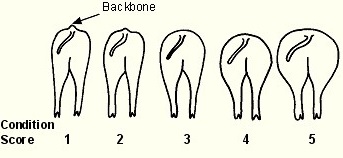The concept of sow condition scoring has been with us for more than 20 years and yet problems with condition are regularly encountered.
The key to maintaining satisfactory even condition throughout the life of the sow lies in the management of the maiden gilt. Body condition is a combination of both the lean tissue and fat components of the body.
Fat is a reservoir of energy sources and, thus, if the breeding life starts with insufficient fat reserves, there is less likely to be sufficient reservoir to meet the demands of production through life. It is usually quoted that a maiden gilt should have a back fat level (at the P2 measurement) of 20mm. However, very few farms have the technology available to measure this. This issue has become more significant in the last few years as increasingly producers have retained bacon pigs for breeding - the result of economic pressures and then difficulties in obtaining gilts due to Foot and Mouth restrictions. The slaughter generation is bred for maximum lean tissue growth and minimum fat levels. The demands of the processors means that a target of 85-90% of pigs should have a P2 of less than 12mm at slaughter around 100kg liveweight. Selection of gilts from the bacon house for breeding done on physical appearance alone is likely to select those animals with lower fat levels as being the best growing. This leaves 6-7 weeks in which to nearly double the backfat level in an animal specifically bred not to deposit fat! Careful diet selection is needed. Specific gilt diets are available, which have high energy low protein specification. Dry sow diets are commonly used in herds that cannot justify a third breeding diet. Lactation diets have high energy and protein and lysine levels that are close to those of a finishing ration, which would be designed to limit fat deposition. It is thus unsatisfactory to use a lactation ration to rear gilts. However, to achieve satisfactory ovulation rates, high protein/lysine intake is needed for 2 weeks prior to service. Therefore, this is the time to introduce lactation ration.
To help further achieve target fat levels in the homebred gilt, aim to remove them from the finishing herds early - say at 75-80kg switching to dry sow or specific gilt rearer fed ad lib or to appetite up to 2 weeks prior to service when the switch to ad lib lactator should take place.
Having established condition in the gilt at service, the challenge is to maintain an even condition throughout life - an aim that may be difficult to achieve in modern loose housed systems where competition for food is the norm. Certain rules of thumb should apply:-
1) Maintain a 2 feed regime using dry sow and lactation diets to meet the needs of sows at different stags of the cycle. Cut backs to save costs are a false economy.
2) Have shedding pens available to be used for sows that are being bullied out of dry sow areas or, indeed, are themselves bullies.
3) Feed sows during lactation as much as possible, ensuring free water supply, good temperature control and at least 2 feeds per day with a follow up round - certainly at the afternoon feed - to provide "seconds" for any sows that have cleared up their food.
4) Do not forget parasite control. Both mange and worms can have a significant draining effect on resources and exacerbate condition problems in sows.

Figure 1 - the standard 5 point scoring system for sow body condition
Score
1 Emaciated with backbone ribs and pelvis prominent
2 Thin with backbone prominent
3 Ideal condition for the farrowed sow - pelvis and backbone just palpable
4 Tending to overweight - backbone not palpable
5 Obese - bony prominences of the body (pelvis, spine, ribs not palpable; tail head submerged in fat folds
A simpler 1-3 scoring system has been applied in recent years based as much on the feel of the ribs as on overall appearance with a target of score 2 for all sows. Score 1 (too thin) means the ribs are easily felt and score 3 (too fat) means they can only be felt with difficulty.
Whatever system is applied the aims must be:
- Start with a gilt in appropriate condition at service
- Maintain as constant body condition as possible
- Maximise lactation intake
- If condition varies beyond the norm aim to restore it as quickly as possible either by adjusting group feeding rates or separating off sows in unacceptable condition for targeted individual feeding.

